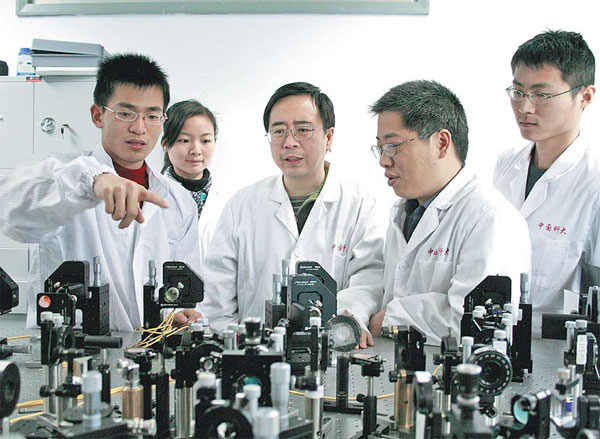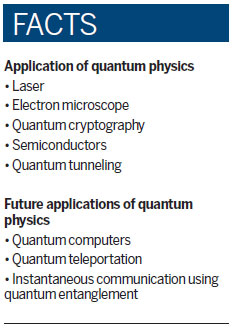Scientist fulfills dream of making physics matter
Let us suppose you carried a safety deposit box all the way from Swiss Valartis Bank to Beijing, only to leave the key in Liechtenstein. What would you do?
This isn't a problem. "Just replicate an identical key in Beijing," says Pan Jianwei, a renowned quantum physicist in China.
|

Pan Jianwei (middle) with his team at Hefei National Laboratory for Physical Sciences at the Microscale. Photos provided to China Daily |

However, in the world of quantum theory - one of the two pillars of modern physics - everything from the key to your safe box to the human body consists of the smallest units of energy such as photons, electrons, and atoms.
What is unique about these microscopic particles, such as photons, is that they can exist in matched pairs, so that the physical property of one photon changes completely and consistently with the other, no matter how far apart they are. As a result, transfers in the properties of matter, like the astonishing technology in Star Trek, are not hard.
Simply speaking, all you need to do with your key in Liechtenstein is to teleport the properties of every quantum photon it consists of to its paired photon in Beijing. Bing! You get a new, identical key.
If so, why would anyone take the trouble to fly from one place to another, instead of quantum teleporting ourselves?
The reason might be that the magic nature of quantum parcels, which Albert Einstein called the "spooky action at a distance", is only theoretical. Previous laboratory experiments managed to teleport a single property but had no luck in teleporting photons with multiple properties, until Pan and his team members' recent success.
The team demonstrated how to transfer the values of two properties of one photon to another. The thesis was published as Nature magazine's cover story in late February and shocked the science community.
"The team's work is a crucial step forward in improving our understanding of the fundamentals of quantum mechanics and the result could also play an important role in the development of quantum communications and quantum computers," says a report by Physics World, the member magazine of the UK's Institute of Physics.
"This is an important step in understanding, and showcasing, one of the most profound and puzzling predictions of quantum physics," Physicist Wolfgang Tittel, from the University of Calgary, wrote in an accompanying article in Nature.

Quantum teleportation first appeared in the early 1990s after six researchers, including Charles Bennett of IBM in New York, developed a basic quantum teleportation protocol. The first experiment in the teleportation of a photon succeeded in 1997 - also published in Nature - and was considered one of the most significant physics theories in the 20th century.
Back then, there was not a single quantum lab in China, while even the word quantum was new to many.
Pan, then a physics student at the University of Science and Technology of China in Anhui province, was one of the few fascinated by quantum theory.
"Newton explained the world by mechanical movement, in which everything is in a state of certainty: A man can be either successful or unsuccessful. And these 'yes or no' answers are too frustrating for people who need meaning for what they do, for their lives," Pan says.
Pan was drawn into quantum theory because of the uncertainty he desired - that photons have a unique nature and can exist in many possible states at the same time.
"This uncertainty is encouraging - if you are on the verge of both success and failure, you are more motivated to make efforts for good results," he says.
For him, a good result was building a world-leading quantum laboratory in China, though he had never laid eyes on a real quantum lab.
With that hope, Pan applied for a PhD program under world-famous experimental quantum physicist Anton Zeilinger, then a professor of the University of Innsbruck in Austria.
At their first meeting, Zeilinger asked Pan about his dream. Pan says it was to build a world-leading lab like Zeilinger's in China. "I always knew he would have a wonderful career - but the incredible success that he has had, I do not think anyone could have foreseen. I am very proud of him," Zeilinger was quoted as saying in Nature. In Zeilinger's team, Pan carried out experiments on quantum communication and quantum computation in Austria, and received a number of awards.
In the meantime, Pan never forgot his dream. Since 1997, he traveled to China for every vacation to propose the building of a quantum laboratory.
"Despite the consensus of the international science community on the revolutionary prospect of quantum technology, domestic scientists had some doubts, some even says quantum science was pseudoscience," Pan says.
Pan's lobbying produced results in 2001, when he started to work for his alma mater under a program called the One Hundred Talents Program, a project launched by the Chinese Academy of Sciences in 1994 to attract Chinese returnees. Pan applied for a 2 million yuan ($319,000) fund to purchase experimental facilities. Unexpectedly, the academy granted 4 million yuan.
With an increasing number of academic achievements being produced, Pan's research team became a formal quantum science laboratory - the Hefei National Laboratory for Physical Science at the Microscale - in 2003.
A laboratory, however, is different from what Pan vowed to build: a world-leading quantum laboratory.
Perhaps being inspired by the no-cloning theorem of quantum mechanics - which tells us that it is impossible to copy a particle perfectly - Pan's plan to make his newly built laboratory stand out from his international competitors was never to copy a world-class laboratory, but to "teleport" one.
Between 2001 and 2008, Pan traveled between Hefei National Laboratory and the University of Heidelberg in search of technology and talents. In 2009, Pan relocated the entire laboratory to Hefei, from the equipment to the research staff.
"The detailed list of relocation was 120 pages long, from large lasers devices to 12 millimeter lens. I shipped them back home," Pan says.
Besides the devices, the laboratory gathers experts from world-class laboratories like Yoshihisa Yamamoto's Group at Stanford University, Nicolas Gisin's group at the University of Geneva and Immanuel Bloch's Group at Max Planck.
The success redounded Pan and his research fellows with honor, but Pan says honor was not what he had sought. Recalling the moment he felt most proud of, Pan says it was the time he was climbing a mountain in Germany and met an old lady. The old lady looked Pan up and down, and seemed to suddenly remember him. "I know you, you are the quantum guy, I read about you in a magazine," she says to him.
"It was then that I felt that what I had been doing was not only something a few sophisticated professors care about," Pan says.
"Instead, quantum science is meaningful because it represents the future, the direction that will change ordinary people's lives, so that an old lady you come across on a mountain hike cares about it."
chengyingqi@chinadaily.com.cn
http://europe.chinadaily.com.cn/epaper/2015-03/20/content_19862506.htm